New York restaurateur Stratis Morfogen is on a mission to reestablish the automat. In fact, he calls the contactless, vending-machine-like format “the future of retail and hospitality”. And he’s now bringing it to 185 locations with Brooklyn Dumpling Shop, a concept launched just last year that has since grown into a full-fledged franchise operation.
The concept features a menu based around “deli-style dumplings”, also referred to by Morfogen as “two-ounce sandwiches”. Think dumplings, but packed with fillings like Philly cheesesteak, reuben, bacon cheeseburger, and even peanut butter and jelly. The idea isn’t new for Morfogen, who first started selling the dumplings at his Manhattan-based restaurant Brooklyn Chop House. Here, they became an instant hit, which prompted him to start shaping plans for his first quick service restaurant (QSR), and not long after, an automat empire.
We sat down to chat with Morfogen about his tech-forward dumpling shop concept and why he thinks a modern automat system is the future for QSR and beyond.
You opened your first Brooklyn Dumpling Shop last spring. But your idea to create a 100-percent contactless restaurant was one you had before the pandemic, correct?
I created the automat concept in 2019, and we were under construction in January 2020. But then COVID hit. The funny thing is, we didn't do this for safety reasons. That was the last thing on my mind. I did it for efficiency and economics. The only thing that we added [out of the pandemic] was the UV lights [in the lockers]. The restaurant was pretty much set up by May 2020, but there was no reason for me to open with all these restrictions and mandates.
We [waited and] opened the flagship in May of 2021. And at that point, we had already sold about 50 franchises.
How did you become a franchisor before ever opening your doors?
What happened is some journalists started to look through the window, and they saw this really interesting piece of machinery – I call it the Tesla of automats. We created it together with Panasonic, [and] the whole thing is controlled by your phone. On the [journalists’] discovery day, the restaurant was pretty much ready to go. And so what happened is QSR magazine, Franchise Times, New York Post, they did all these stories [before we ever opened].
The franchisees would come to the shop and test the technology, and then they’d go over to Brooklyn Chop House to try the dumplings. So they’d get a taste of what’s to come. And then everybody was buying territories.
Let’s talk about how your automat system works. Can you give me a quick rundown?
We created a handheld, phone-controlled ordering system, where the consumer can order ahead on our website and schedule a time to come pick it up, either right at the store or have it delivered. If they arrive at the store, they receive a QR code on their phone. All they do is walk into the store, scan their phone, and a locker opens. They take their food, and go.
The relationship with the consumer is only with their locker. It has nothing to do with staff. I actually don't even care if they speak to my staff. There's always a greeter in the front. And we always have a support crew in the back doing expediting, prep like refilling inventory, and a cook. I have the financial models that show that you can service 500 people in a day with three to four employees. That will bring the payroll down to 15-percent instead of the industry norm of 30-percent. And that's our goal at Brooklyn Dumpling Shop – to create a QSR where the consumer is in full control and the franchisee has a 15-percent payroll. Then we’ve revolutionized the whole industry.
So reducing staff is obviously the biggest business benefit here. Are there any other major benefits that you see from this concept?
So many to list, but I’ll give you a few of them. When you're doing automat, you don't need a big footprint – smaller footprint, smaller labor force. We're talking Brooklyn Dumpling Shop with 800 square feet capable of doing two- to four-million in sales. Remember, we're focused on the TikTok generation, which also overlaps with the university students. They want to order online, come and grab their food, and they don't want to be speaking to you at all. You're also allowing the consumer to be in control, where the consumer decides when they want to pick up, and you totally knock out human error.
I'm also putting the automat in my fine-dining restaurants. I'm going to put the automat flush with the curb, like an ATM machine, and the third-party delivery drivers and people that want to pick up don't have to enter the restaurant. Then I don’t need people at the register stapling bags, and saying UberEats gets this, Mikes gets that. It goes right from the kitchen to the back of the automat.
Do you plan to expand your reach to older generations through education, or is your sole focus here on a younger demographic?
This is for the TikTok generation – 12- to 30[-years-old]. All they know is iPhone and iPads. They don’t need education. But older people like me, we try on a one-to-one basis. Are we going to do a full-on press tour? No, that’s not our market. But every Brooklyn dumpling shop will have a greeter in the front, and that greeter is there to educate. As we do get the 50- and 60-year olds walking in, we try to basically explain to them, ‘Hey, take a look at a new way of ordering.’
What originally inspired you to create a restaurant based off of an automat system?
The dumplings became a gangbusters success at Brooklyn Chop House. So in 2019, around January, I called my partners. I wanted to open up a dumpling shop that was more reminiscent of a sandwich shop. I think we have more competition with a Subway or a Jimmy John’s than a traditional dumpling shop in Chinatown.
I’ve held Chinese restaurants for 17 years, but I also come from a Greek diner background. And I always knew that the dumpling and the sandwich needed to be reimagined. You know, the sandwich, it's boring. We already had the concept where you could get pastrami, gyro, chicken parmesan, buffalo chicken, all in dumpling format. But this would be my first QSR, and I started doing the research. I wanted to know why seven out of 10 fail so fast. The number one reason was payroll. Payroll would kill fast food restaurants. And this was before Covid.
Then I remembered how my dad took me to an automat when I was 10-years-old, and I wanted to know what happened to the automat.
And what did you discover – how did the automat fall out of popularity?
So in 1902, Horn and Hardart created the automat. Post Spanish Flu,1922, they went from two locations to 40 locations. People loved the idea of it being contactless, especially after the Spanish Flu. Weirdly enough, I’m dealing with the same thing 100 years later. But getting back to what I can control, I wanted to know why it fell.
After it was glamorized for about 50 years in Hollywood, the automat failed in the ‘70s because technology failed the automat. Inflation was sky-high in the ‘70s. Now, a lunch wasn’t 25 cents and a dinner wasn't a dollar [anymore]. It was also the rise of fast food, where you go to a McDonald's or KFC or Pizza Hut, and you can actually pay with a credit card, a new form of payment in the early ‘70s. And then what happened with that is you couldn't do that with the automat. There were no dollar bill receivers. There were no credit card processing machines. Now you have a family of four, and you're going to need about $10 in change. The concept became outdated, and technology put the death nail in it.
I said you know, if we do driverless cars, I think it's time to bring back the automat because I do think the automat is the most cost-effective, efficient way to deliver a product. I don't care if it’s a hamburger or a dumpling or a pair of jeans. So I wanted to create a high-tech concept of the automat, a new version the way Elon Musk did with a car, where the customer controls the whole order process through their phone without the need for a cashier. Everybody has self-ordering kiosks now. But [even with that], most likely you're going to have to get [your order] by a cashier, and that's not a model that I think is efficient or effective or scalable in a fast-paced environment like the franchise world.
Can you tell me a little bit more about how the locker system works?
The QR code gives you the key to the locker. You scan the QR code, and the automatic door opens up. It’s either refrigerated at 38 degrees or heated at 150 degrees. It’s all temperature-controlled, and everything has UV lights. UV lights will burn any bacteria, germs, or viruses inside the box. I brought the idea to Panasonic, and they executed my vision. And now you can imagine, I have big chains that are coming to me now just to license my software. It’s a whole new business for me.
An automat controlled by your phone, they’ll work with the cannabis industry, they’ll work with the Gap. Can you imagine ordering a pair of jeans, and saying you don’t want to go inside the store to pick them up. Imagine doing it all on your phone, then showing up to the Gap, and there’s an automat flush with the curb. I look at this at the future of retail and hospitality.
So you obviously envision the automat coming back into popularity.
Unless you're hiding behind a stone, you bet. If you think that cashiers are the wave of the future, you're still back in the ‘90s. Cashiers are gone, the same way tollbooth workers are gone. There's no reason to have a cashier at a fast-food restaurant.
I think it's going to be in all types of retail. People want to control their lives by their phones. They want it on their time.
Do you think the automat concept is the primary draw for people coming to your dumpling shop, even beyond the food?
The ease of use is the number one draw. But if the food sucks, they're going to come take an Instagram picture, and they're going to leave. Your food's got to be great. I would say we did 1,000 covers yesterday and maybe 30 people sat in the restaurant. They were just taking the food and leaving, in and out in five seconds.
Do you think the contactless concept will continue to sustain itself even as more people return to indoor dining?
This has nothing to do with the pandemic. People are still going to go to fine-dining restaurants. We’re talking about fast food, fast casual. If you’re not going heavy on technology, I think you should consider getting a new profession.
I'm showing [franchisees] a way to have an 800-square-foot store and three to four million [dollars] a year. It’s smaller footprint, smaller labor force, smaller overhead like utilities and everything else, smaller insurance, smaller liabilities, and maximum profits.
I imagine becoming a franchisor was always part of the plan.
I figured I'd open three stores on my own, prove the concept for two to three years, and then enter the franchise market. The cart got in front of the horse. I have to manage my time now to support 185 franchises that are going to be opening in the next three years.
The future is automation. I’m actually now working with Miso Robotics to automate my whole kitchen. My goal is to have one employee run a restaurant doing five million [dollars] a year. That’ll take two years.
What would you say to someone who raises the question of this taking away jobs?
Seven out of 10 restaurants fail within three years. The number one reason is excessive payroll. If we can trim down the payroll from 30-percent to 15-percent, guess what, we can save jobs. Let's say each of those traditional restaurants have 10 employees, and for every hospitality job that’s lost, 10 people lose their job – truckers, drivers, vendors, suppliers, you name it. So now that’s 700 people losing their jobs because seven out of 10 [restaurants] fail. Wouldn't it be great if seven out of 10 [restaurants] could succeed with half the payroll? Guess what, you’re saving jobs by using technology. It’s simple math. And we’re also upping productivity.
Actually a lot of jobs are created behind the scenes. Isn't there someone coding? Building up that platform so everything can be seamless and streamlined? It might not be that person collecting change. But we have to advance technology, like Uber advances [the] taxi driver.
You mentioned you’re creating an automated kitchen with Miso Robotics – any other tech-forward plans you have for the future?
I just came out with the first NFT private member's club in Times Square, two levels below Brooklyn Chop House. It’s in the New York Post today. We’ll be the first restaurant to do strictly NFT.
I’m creating a 100-percent contactless drive thru that’s being developed now. And I have a book, Be a Disruptor, coming out in May. I’ve disrupted everything in my life since I was six years old. The whole book is about disruption.





